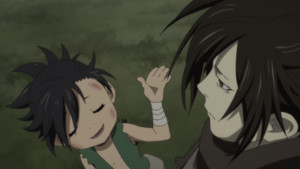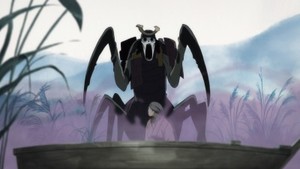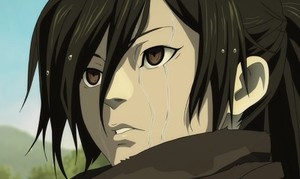The Winter 2019 Anime Preview Guide
Dororo
How would you rate episode 1 of
Dororo (TV 2019) ?
Community score: 4.6
What is this?
 In the Sengoku era, a lord makes a terrible pact with the demons of the Hell Shrine – he will give them anything if they will save his lands from famine and war. The demons agree to the bargain, and when Lord DAIGO's son is born, it becomes clear what the demons have taken. Since the child has no eyes, nose, skin, or anything else, Lord DAIGO instructs the nursemaid to drown him in the river. Unable to do so, she instead sets him adrift in a rowboat. Sixteen years later, a young thief named Dororo encounters a mysterious young man wearing a mask who goes around hunting demons. Could this be the child DAIGO gave up years ago? Dororo is based on a manga and streams on Amazon on Mondays.
In the Sengoku era, a lord makes a terrible pact with the demons of the Hell Shrine – he will give them anything if they will save his lands from famine and war. The demons agree to the bargain, and when Lord DAIGO's son is born, it becomes clear what the demons have taken. Since the child has no eyes, nose, skin, or anything else, Lord DAIGO instructs the nursemaid to drown him in the river. Unable to do so, she instead sets him adrift in a rowboat. Sixteen years later, a young thief named Dororo encounters a mysterious young man wearing a mask who goes around hunting demons. Could this be the child DAIGO gave up years ago? Dororo is based on a manga and streams on Amazon on Mondays.
How was the first episode?
 James Beckett
James Beckett
Rating:
Hot damn, what a premiere! I've long been aware of the existence of Osamu Tezuka's Dororo manga, but I've never been able to check it out for myself, nor have I seen the original anime from the 1960s, so I went into this one knowing little more than the basic gist: a wandering swordsman with prosthetic limbs teams up with an orphan named Dororo, in true ronin fashion. The first thing that stood out for me in MAPPA's adaptation is how they've modernized Tezuka's aesthetic, managing to preserve little bits of his round and flexible style while still crafting a distinctly modern look for the show. The opening scenes set an ominous and intriguing tone, as we watch the devilishly ambitious DAIGO offer his first son as food for demons, and when he and the audience finally lay eyes on the poor child, he's missing his limbs, his eyes, his nose, and even his skin. It's an unnerving sight to say the least, enough to give the baby from Eraserhead a run for its money.
The child who will grow up to be named Hyakkimaru is given the Moses treatment and sent down the river by a sympathetic nanny, who is promptly devoured by a demon for her troubles. This is where all of Dororo's moodiness and atmosphere gets married with some of the stellar action and animation that MAPPA and Tezuka Studios are clearly quite excited to show off, when a blind swordsman with the power to sense evil auras makes quick work of the riverside demon. Not only is this an exceptionally cool cut of animation, it's a handy way to segue the story into sixteen years in the future, where the doomed young baby has grown into a monster-murdering badass who can toss away his prosthetic hands to kill things with sword arms.
We also meet the titular Dororo, a young orphan thief whose especially Tezuka-esque features mark him immediately as the plucky, motor-mouthed protagonist that will accompany Hyakkimaru on whatever strange journey of revenge and discovery lies ahead. I really like Dororo – he's the kind of plucky kid sidekick that gives the anime a classical edge obscured somewhat by its updated aesthetic, and I appreciate anyone who'll still give bullies some well-deserved grief, even after they've been beaten down two times over. Hyakkimaru gets to show off his own monster-slaying skills when an evil muck golem makes quick work of the thugs that were harassing Dororo, meaning that this premiere is two-for-two when it comes to fantastically choreographed and tightly directed action scenes.
The best thing a premiere can do is leave me positively ravenous for more when the credits roll, and Dororo's inaugural episode did just that. I'm a sucker for tone-driven period pieces like this, and the setting's supernatural flourishes are right up my alley as well. If the series' story can live up to this promising setup, and if MAPPA can maintain the production quality all the way through, I will have absolutely no problem keeping up with Dororo weekly.
 Paul Jensen
Paul Jensen
Rating:
At some level, Dororo faces a similar task to last year's Megalobox: taking a decades-old classic and making it feel as fresh and relevant as any modern series. In terms of approach, though, Dororo feels more like a direct adaptation than a “spiritual successor” reimagining like Megalobox. There's no sci-fi twist to mix things up, just a fresh coat of paint to bring the character designs into line with current aesthetics. The result is a striking premiere that embraces the grim nature of its premise and presents it in a way that feels compelling on an almost primal level.
More than anything else, I have to give this episode credit for finding its voice early and setting a clear tone for the story. The setting is by no means a nice place to live, to the point where even a merciless leader like DAIGO is at the end of his rope. Even before we see the disfigured child, it's clear that DAIGO's bargain will carry a high price. By the time we get to the river scene, the image of a demonic mantis mowing down an elderly woman feels like a perfectly natural occurrence. It's an atmosphere that speaks to our instinctive fear of what might be lurking in the shadows, and boy does it work. Here be monsters.
Just as the gloom and doom starts to feel oppressive, we're introduced to young Dororo, who's clearly meant to serve as a spark of life in the story. The series will need to walk a fine line with this kid, as he could easily come across as shrill or annoying if the writing doesn't stay on point. For now, though, he's just about right: crafty and independent enough to survive, but still well-meaning and innocent enough to serve as the story's conscience. As for our silent swordsman, I'm not sure I could ask for much more out of his introduction. His performance in the fight scene establishes him as a certified badass, and yet the image of Dororo helping him reattach his prosthetic hands lends him the right level of vulnerability. The two of them together should make for a well-balanced pair.
My one concern here is that this episode is so consistently dark that it ends up feeling more exhausting than cathartic. The swordsman's victory over the trash monster feels somehow hollow, and we really need some extended moments of relative peace if we're going to connect with these characters on an emotional level. Of course, there should be plenty of time for that later in the season, and for now this premiere displays more than enough potential to catch my interest. As long as you don't mind your anime dark and violent, Dororo is definitely worth checking out.
 Nick Creamer
Nick Creamer
Rating:
Based on a manga by the god of manga himself, and adapted by a veteran director over at studio MAPPA, I had a variety of reasons to be excited for this season's Dororo. After watching this premiere, I'm happy to say it soundly trounced my expectations, and offered what will likely be one of the strongest premieres of the season. It's a whole lot easier to pull together a great premiere than a great full show, but Dororo is certainly offering a strong opening salvo!
This episode opens by introducing us to DAIGO Kagemitsu, a feudal lord who makes a pact with demons in order to ensure his region's prosperity. From the start, I was impressed by Dororo's beautiful painted backgrounds and stately, confident pacing, as DAIGO's journey to this unholy pact was depicted with as little unnecessary dialogue as possible. What dialogue does exist feels weighty and iconic, like DAIGO responding to a priest's pleas not to condemn himself with “Priest, we are already in hell.”
Throughout this episode, Dororo manages a compelling balance of theoretically slow moment-to-moment pacing that is counterbalanced by its naturally punchy and never overtold storytelling. Because of this, the show is able to feel like an atmospheric and mournful tone piece while also carrying us through a serious chunk of storytelling, with this episode gracefully including a time skip, two fights with demons, and the initial meeting of young thief Dororo and DAIGO's cursed son. Sequences like the approach of that second demon are allowed the quiet space necessary to build a real sense of suspense, and when the scene erupts, it does so in an energetically choreographed and beautifully animated fight sequence. It's no surprise to me that director Kazuhiro Furuhashi directed the acclaimed Trust and Betrayal Kenshin OVA—Dororo exhibits the same style of consistently weighted and brutally fast action sequences, lending a sense of solidity to concepts like a mud demon entombing itself in a collapsing bridge.
Overall, I have basically no complaints about this first episode. Its storytelling was intriguing and very confidently conveyed, its general aesthetic and tone are confident and gripping, and its fight scenes were terrific. Even the musical score is firing on all cylinders, with koto strums timed to match the ebb and flow of battles. If you're looking for a samurai-era adventure this season, Dororo offers a terrific start.
 Rebecca Silverman
Rebecca Silverman
Rating:
This is my first major experience with Osamu Tezuka's Dororo (I read a little of the manga at the library), mostly because I tend to prefer Shigeru Mizuki for mangaka of that era. But whether you're familiar with Tezuka's tale of Hyakkimaru and Dororo's monster-hunting travels in the Sengoku Era or not, this first episode is truly impressive. It's definitely in a getting-off-the-ground vein, however, but unlike many episodes of that ilk, it manages to be intriguing despite the fact that we have very little clear idea of where the story's headed.
Things begin with one of those amazing blood-and-sweatless anime births. The child being born is the first for DAIGO, lord of a fiefdom that has suffered from famine and natural disasters. In an ill-advised attempt to save his lands and people, DAIGO pledged himself to the demons of the Hell Shrine, offering them whatever they wanted in exchange for their protection. Since that rarely goes well (see: all of folklore), the result is that his child is born as a flesh-covered skeleton with no skin, eyes, ears, you name it. Despite his wife's pleas, DAIGO orders the child killed, and only a compassionate nursemaid saves the baby, setting him adrift in a rowboat instead of drowning him…before being eaten by a praying mantis demon. That right there should indicate that the child wasn't likely to be the only price for the protection of the lands – presumably a yearly tithe of people will also need to be paid to hungry monsters.
At this point the story skips ahead sixteen years to a young thief named Dororo almost getting killed and then being saved by Hyakkimaru, the grown-up version of DAIGO's baby. Since Hyakkimaru can't speak (and Dororo can't shut up), the two seem like a perfect pair, and not just because Hyakkimaru saved Dororo's life. Of course, that wasn't entirely intentional – Hyakkimaru was actually hunting a demon that happened along and ate the grown men trying to drown and/or beat to death Dororo for stealing their stuff. That's a hard scene to watch, and while Dororo is a scrapper and has zero intentions of going down easy, seeing an eight(ish)-year-old almost be killed by a group of full-grown men is very uncomfortable. This is enhanced by the fact that this is a beautifully animated episode and that Tezuka's dated character designs have been updated to appeal to a modern audience while still retaining their characteristic look. It's most obvious in Dororo, but everyone retains Tezuka's deceptively simple style, and it works to help give the feeling that this is an old story. The choice of primarily sepia tones in the artwork also adds to this to good effect.
The ending of the episode implies that the curse on Hyakkimaru can be undone if the correct demons are killed, allowing him to take back what his father gave away. While that could devolve into a monster-of-the-week series, it's worth checking this out anyway, because there's enough done right here that this feels like a fitting adaptation of Tezuka's work.
 Theron Martin
Theron Martin
Rating:
It's rather ironic that one of the best-looking series of this season also depicts some of the ugliest material. But that's what studio MAPPA has accomplished in this new adaptation of Osamu Tezuka's late '60s manga. This is the kind of series where manure gets flung as a weapon, the skeletal remains of a dog are seen alongside the side of the road, and bloody slaughter commences on the regular, and yet it still looks gorgeous. Despite taking occasional shortcuts, the animation is smooth and detailed, and the use of color schemes to control the tone – alternating from grim and earthy to vibrant as the story shifts between matters of death and life – is strikingly effective. Few other series use CG like this, to produce the hazy supernatural sensing of evil. This all builds to a dazzling action sequence where the co-protagonist duels a mud demon. Nothing about this production looks like it's based on 50+ year old source material, so if you don't favor older art styles then that won't be a problem. This is an update meant to make the content accessible to the current generation of anime fans.
The story also has potential. The original manga involved 48 demons, but this one had been pared down to 12, presumably because of a shorter runtime. The concept is still the same: a wandering ronin is missing assorted body parts because of an agreement struck by his feudal lord father. The first episode doesn't make it clear that slaying the demons freed by his father is what allows the ronin to recover the body parts he lost at birth, but the first clue to this comes up at the end of this episode. The story isn't actually named after this ronin, however; it's instead the name of the rambunctious boy who survives through theft and resale, soon to be acting as the ronin's traveling companion. He's the kind of irrepressible youth that Tezuka stories are known for, and while he strains credibility by being chipper even when getting beaten down and threatened with death, it's hard not to like him. The ronin hasn't shown much personality yet, but he's got swords in place of arms (with prosthetics to fit over them) and has combat talents that would put Daredevil to shame. That's compelling in its own right.
At heart, this story is a simple one, with the only major potential twist being that the ronin might eventually encounter his younger brother, but this is still a debut well worth checking out.
discuss this in the forum (621 posts) |
this article has been modified since it was originally posted; see change history
back to The Winter 2019 Anime Preview Guide
Season Preview Guide homepage / archives